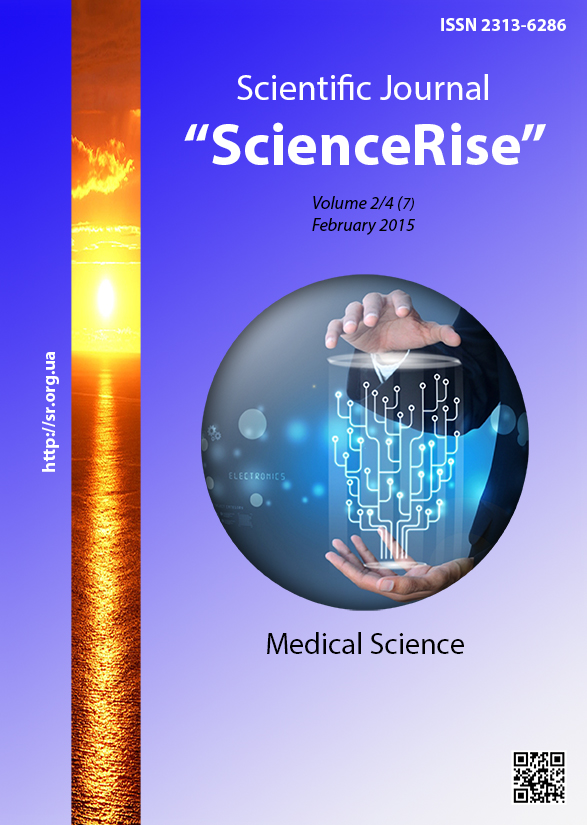Incontience of urine duration after a radical prostateсtomy and efficiency of training of muscles pelvic floor under control of biofeedback
DOI:
https://doi.org/10.15587/2313-8416.2015.37727Keywords:
radical prostatectomy, urine incontience, biofeedbackAbstract
Aim. To compare urine incontience duration after a prostaektomy and efficiency of training of muscles of a pelvic floor.
Methods. We applied training of muscles of a pelvic floor under control of biofeedback at 142 patients. Up to 2 months after operation 78 patients had an urine incontience. 64 patients had an urine incontience more than 2 months .
Resuult. Terms of restoration of continence of urine after training of muscles of a pelvic floor in groups had no significant distinctions (p=0,371)
Conclusions. Training of muscles of a pelvic floor under control of biofeedback allows to activate functional ways of continence of urine.
References
Hunter, K. F., Moore, K. N., Cody, D. J., Glazener, C. M. (2004). Conservative management for post-prostatectomy urinary incontinence. Cochrane Database Syst Rev.
Nahon, I., Dorey, G., Waddington, G., Adams, R. (2006). Systematic review of the treatment of post-prostatectomy incontinence. Urol Nurs., 26 (461), 75–82.
Filocamo, M., Limarzi, V., Popolo, G., Cecconi, F., Marzocco, M., Tosto, A., Nicita, G. (2005). Effectiveness of Early Pelvic Floor Rehabilitation Treatment for Post-Prostatectomy Incontinence. European Urology, 48 (5), 734–738. doi:10.1016/j.eururo.2005.06.004
Floratos, D. L., Sonke, G. S., Rapidou, C. A., Alivizatos, G. J., Deliveliotis, C., Constantinides, C. A., Theodorou, C. (2002). Biofeedback vs verbal feedback as learning tools for pelvic muscle exercises in the early management of urinary incontinence after radical prostatectomy. BJU International, 89 (7), 714–719. doi:10.1046/j.1464-410x.2002.02721.x
Van Kampen, M., de Weerdt, W., Van Poppel, H., De Ridder, D., Feys, H., Baert, L. (2000). Effect of pelvic-floor re-education on duration and degree of incontinence after radical prostatectomy: a randomised controlled trial. The Lancet, 355 (9198), 98–102. doi:10.1016/s0140-6736(99)03473-x
Hunter, K. F., Moore, K. N., Glazener, C. M. (2007). Pelvic floor muscle training to improve urinary incontinence after radical prostatectomy: a systematic review of effectiveness. BJU International, 100 (5), 1191–1191. doi:10.1111/j.1464-410x.2007.07248_1.x
Krupin, V. N., Belova, A. N. (2005). Incontinence of urine. Neurourology (book). Moscow.
Bulmer, P., Abrams, P. (2004). The Unstable Detrusor. Gynecol Obstet Invest, 72 (1), 1–12. doi:10.1159/000075265
Hunter, K. F., Moore, K. N., Glazener, C. M. (2007). Pelvic floor muscle training to improve urinary incontinence after radical prostatectomy: a systematic review of effectiveness. BJU International, 100 (5), 1191–1191. doi:10.1111/j.1464-410x.2007.07248_1.x
Bales, G. T., Gerber, G. S., Minor, T. X., Mhoon, D. A., McFarland, J. M., Kim, H. L., Brendler, C. B. (2000). Effect of preoperative biofeedback/pelvic floor training on continence in men undergoing radical prostatectomy. Urology, 56 (4), 627–630. doi:10.1016/s0090-4295(00)00687-7
Seckiner, I., Yesilli, C., Mungan, N. A., Aykanat, A., Akduman, B. (2007). Correlations between the ICIQ-SF score and urodynamic findings. Neurourology and Urodynamics, 26 (4), 492–494. doi:10.1002/nau.20389
Downloads
Published
Issue
Section
License
Copyright (c) 2015 Юрий Леонидович Демидко, Андрей Зиновьевич Винаров, Леонид Михайлович Рапопорт, Вагаршак Арамаисович Григорян, Евгений Алексеевич Безруков, Денис Викторович Бутнару, Лилия Саидовна Демидко, Сергей Алексеевич Мянник, Тимур Барабекович Соблиров

This work is licensed under a Creative Commons Attribution 4.0 International License.
Our journal abides by the Creative Commons CC BY copyright rights and permissions for open access journals.
Authors, who are published in this journal, agree to the following conditions:
1. The authors reserve the right to authorship of the work and pass the first publication right of this work to the journal under the terms of a Creative Commons CC BY, which allows others to freely distribute the published research with the obligatory reference to the authors of the original work and the first publication of the work in this journal.
2. The authors have the right to conclude separate supplement agreements that relate to non-exclusive work distribution in the form in which it has been published by the journal (for example, to upload the work to the online storage of the journal or publish it as part of a monograph), provided that the reference to the first publication of the work in this journal is included.

